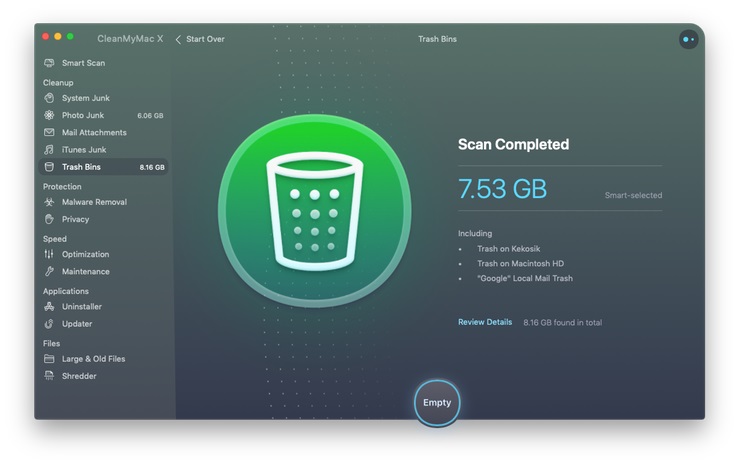

- COMMAND LINE FORCE EMPTY TRASH FULL
- COMMAND LINE FORCE EMPTY TRASH ISO
- COMMAND LINE FORCE EMPTY TRASH MAC
If I delete those folders, then seem to not delete and rename themselves. When I do, I get a new directory appear in the folder called expunged If I go into the directory, I can seemingly delete the folders. While in Ubuntu, I tried deleting the folder. The only way it seems I can delete this folder is to format the drive. Rm: cannot remove 'files/OU/ESSAYS': Directory not emptyĮven though everything I am reading is saying -rf should removed everything, empty or not, it's crying because it's not empty.Īny other nuke commands you are aware of?ĭo I need to get someone to remove a curse from this drive? This command should work no matter what, it's basically a hard kill switch command for files when run as root lol. The -rf is 2 flags, recursive (gets any sub folders), and force (ignores all errors) and running with sudo gives the command max root permission Surely there is a way to just nuke it?Įven from terminal level? you should be able to ignore the errors and delete the directory with the following command

I just want to reclaim my HD space back and I am lost on how I force a deletion of a directory. So when I rebooted I had this big fat trash directory.Įven booting back into Linux didn't work as the errors were similar. But being as smart as me, I didn't empty the trash after deletion. Automatically empty the Deleted Items folder.
COMMAND LINE FORCE EMPTY TRASH ISO
I loaded up a Linux ISO from USB and delete the files. In the folder list, right-click the Deleted Items folder or the Trash folder, and then select Empty Folder. I couldn't delete the folder however, similar errors to this. So my solution was to delete the onedrive folder and re-download all my files. It kept saying all the files were corrupt.Īt a guess I would say that the Onedrive folder acts as some kind of symbolic link to somewhere. For whatever reason it did not like to play with my Onedrive directory on another drive. This is what happens when I try to delete the trash-999 directory:įor those wondering how I got in this state, here is a totally skippable back story. The problem is my C drive hasn't enough room to spare since this directory is over 270gb in size. I read a previous trick here which said to move it to my C drive and call it Windows.old and run a disk cleanup. Some directories allow me to delete it, some cry it isn't empty, which it is (I've got show hidden files option ticked). Even if I delete everything out of the directory. If I dig into the directories, I can see and delete individual files but the directories themselves I sometimes can't delete. I've used Unlocker and Lockhunter, both fail to delete it. I've added myself to permissions again, unable to delete because of some "unknown error". However the second folder is more troublesome.
COMMAND LINE FORCE EMPTY TRASH FULL
I managed to delete the first one by adding my user in permissions with full control. Do let me know if you face any issue.I had two directories which are. I hope this little tip worked for you and you can empty the trash without any further issue in Ubuntu or any other Linux distribution. Keep in mind that if you delete files in Linux using the rm command, it doesn’t go to the recycle bin. If you delete any new files, you should not be having the same freezing Nautilus issue again. Once you use that command, you’ll see that the Trash has been emptied.

In other words, it is emptying the trash in command line way. The above mentioned command is deleting all the files in Trash directory. You could cd into trash first and then remove the content of the directory.
COMMAND LINE FORCE EMPTY TRASH MAC
Option + Shift + Command + Delete Without the need for confirming your intention and empty the Mac Trash, you can simultaneously hit the 4 keys: Option, Shift, Command, and Delete. Otherwise recovering deleted files in Linux is a painful job. To immediately empty the Mac Trash, just press Shift, Command, and Delete, then choose Continue to confirm. I trust you that you won’t be deleting any other files or directory. Now, be careful in what you type with rm -rf. Open a terminal and use the following command: rm -rf ~/.local/share/Trash/* To empty trash, you can delete the contents of this directory. local/share/Trash/ in your home directory. The location of the trash in Ubuntu (and other Linux) is. But I do have a solution for you if you too are facing issue in deleting the trash via GUI in Ubuntu. Honestly, I do not know what caused this issue in the first place. Method 2: Empty trash from terminal in Linux And my repeated attempts to delete the trash resulted in same frozen window. I had to kill the process terminal.īut this was painful because the files in trash were still there. But it just got stuck at it and I got ended with a frozen Nautilus File manager. It took some time with a progress bar showing that it was in the process of deleting the files in trash. I right clicked on the trash icon and chose Empty Trash option, like I always do. But the other day I ran in to an issue while emptying trash in Ubuntu.


 0 kommentar(er)
0 kommentar(er)
